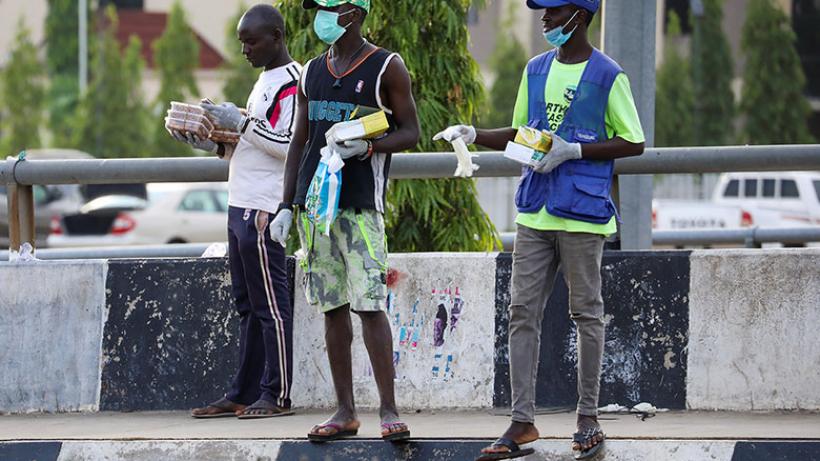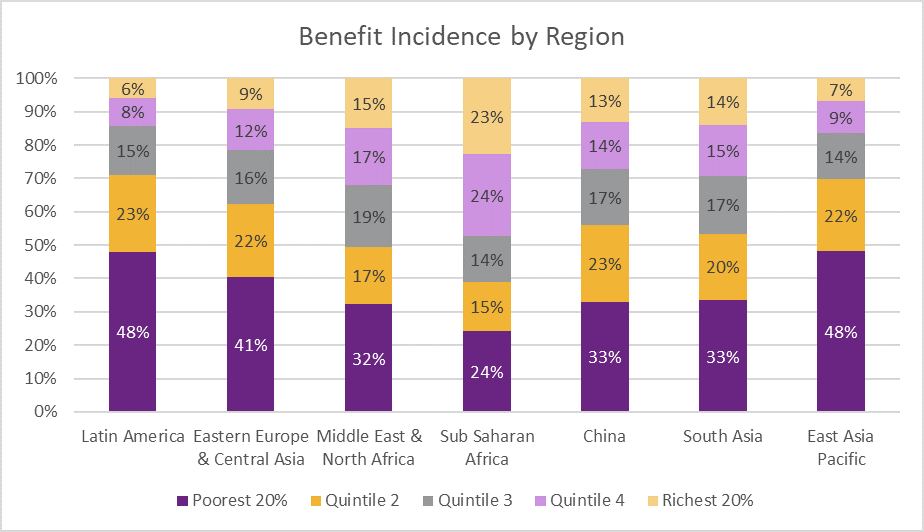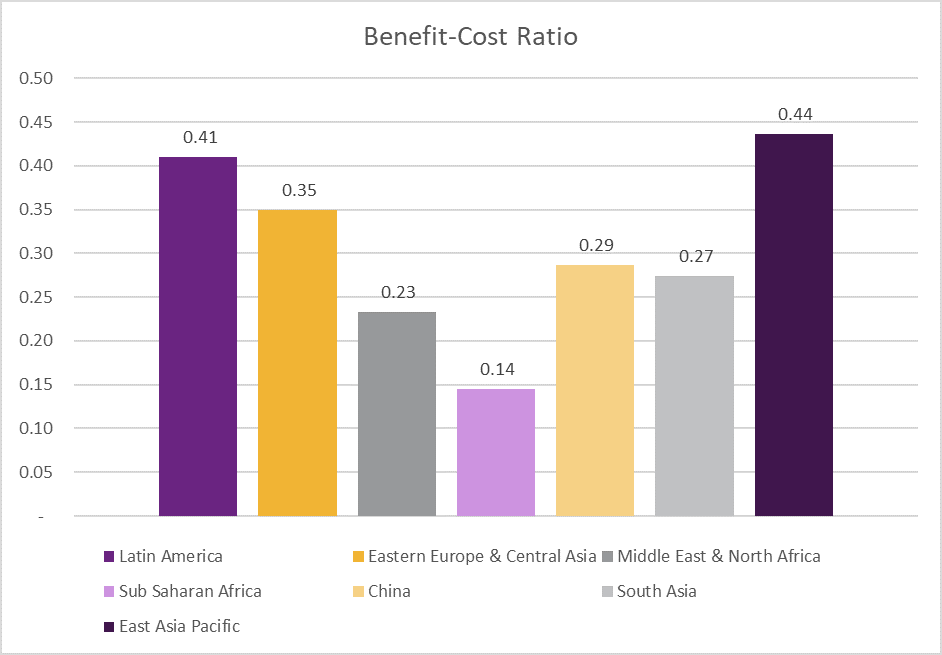
COVID-19 underscores need to overhaul social policies across Africa
Social assistance transfers fail to reach the poorest sections of the population in sub-Saharan Africa. The COVID-19 crisis requires an expansion of our relief efforts beyond traditional social transfers, and is a call to re-envision social policy once we emerge from the carnage of this crisis.
COVID-19 is as egalitarian as climate change. In that, it is not (Dell et al., 2008; Burgess et al., 2017). The brunt of the virus is borne by the most vulnerable and marginalised sections of society. Lockdowns and social distancing, the most common responses, tend to disproportionately affect daily wage labourers, migrants, low-income households, and those living in informal settlements. As of April 17th 2020, in response to these adverse effects of the pandemic and policies to curtail its health impacts, 133 countries planned, introduced or adapted social protection and jobs programmes (Gentilini et al., 2020).
But these social payments are unlikely to reach a large proportion of people in need, particularly in sub-Saharan Africa, because of flaws in the existing model of development and social policy. This does not mean that there should not be increases in transfers. Nor should the immense effort required to find the fiscal capacity and to implement nation-wide reforms in incredibly uncertain times be belittled. This article aims to shed light on how we as a society have failed the marginalised over many decades, and how this crisis requires an expansion of our relief efforts beyond traditional social transfers. It is also a call to re-envision social policy once we emerge from the carnage of this crisis.
The need to revisit social policy
There has been a drastic fall in global poverty over the past 25 years. In 1990, 36% of the world population lived in poverty which fell to 10% in 2015. Yet, 736 million people continue to live on less than US$1.90 a day (World Bank, 2019), most of them in middle-income countries. Apart from in China, growth has not proved to be a successful strategy to alleviate alleviating poverty on a large scale as it hasn’t been all inclusive (Hanna and Olken, 2018). Hence, a renewed focus on redistribution mechanisms such as social assistance programmes is required. Similarly, many experts have called for increases in social protection transfers in response to COVID-19. However, as I illutstrate below, this will not be sufficient in many developing countries, particularly in sub-Saharan Africa.
Social assistance programmes are designed to reach the poorest and/or most vulnerable sections of society. They are non-contributory interventions (i.e. the government or other providers pay the full amount of the assistance) designed to help individuals and households cope with chronic poverty, destitution, and vulnerability. Examples include unconditional and conditional cash transfers, non-contributory social pensions, food and in-kind transfers, school feeding programmes, public works, and fee waivers.
Limited coverage
In many developing countries, the reach of social assistance schemes is limited as illustrated in Figure 1. Sub-Saharan Africa reaches 22% of the poorest 20% of its population as opposed to an average of 63% reached by developing countries in other regions of the world. This implies that if social assistance transfer amounts were increased, 75% of the poorest in sub-Saharan Africa would not benefit.
Figure 1: Coverage of social assistance schemes by income quintile
 Source: Parekh and Bandiera (forthcoming). Calculated using the World Bank ASPIRE database, 2019. India has been reported separately to the rest of South Asia because of the large difference in coverage rates.
Source: Parekh and Bandiera (forthcoming). Calculated using the World Bank ASPIRE database, 2019. India has been reported separately to the rest of South Asia because of the large difference in coverage rates.
Regressive in implementation if not design
Social assistance transfers are not always progressive; i.e. the poorest do not always receive a higher proportion of social assistance. As can be seen in the figure below, the poorest 20% in sub-Saharan Africa receive a similar proportion of all social assistance transfers as the richest 20%! All other regions show a more progressive distribution of benefits. Hence, simply increasing transfer amounts is unlikely to target the lowest income groups in sub-Saharan Africa and, therefore, might not be the most effective targeting tool.
Figure 2: Benefit incidence by region
 Source: Parekh and Bandiera (forthcoming). Calculated using the World Bank ASPIRE database, 2019. India has not been reported separately to the rest of South Asia because the benefit incidence rates were similar.
Source: Parekh and Bandiera (forthcoming). Calculated using the World Bank ASPIRE database, 2019. India has not been reported separately to the rest of South Asia because the benefit incidence rates were similar.
Benefit to cost ratio
Another way to analyse social assistance is through benefit-cost ratios. The benefit-cost ratio is lowest in sub-Saharan Africa (0.14), which means that the poverty gap reduces by 14 cents for each US$1 spent on social assistance programmes in sub-Saharan Africa – quite low compared to East Asia-Pacific (41 cents) and Latin America (44 cents). Hence, sub-Saharan Africa will also require to dispense more funds through social assistance programmes in order to fill the poverty gap and raise vulnerable people to a minimum income base.
Figure 3: Benefit-cost ratio
 Source: Parekh and Bandiera (forthcoming). Based on calculations on the World Bank ASPIRE database, 2019. India has not been reported separately to the rest of South Asia because the benefit-cost ratios were similar.
Source: Parekh and Bandiera (forthcoming). Based on calculations on the World Bank ASPIRE database, 2019. India has not been reported separately to the rest of South Asia because the benefit-cost ratios were similar.
Social policy solutions
While the situation is bleak and an increase in social assistance is unlikely to be the magic bullet we hoped for, it is a start to reducing the burden of the virus on low-income, marginalised and vulnerable groups. Additional potential policy solutions in the short-run include:
- Expanding social transfers in both value and coverage to reach as many in need as possible. The aim of social policy must shift to reducing exclusion errors instead of curtailing inclusion errors, which often is the goal in “normal” circumstances. Hence, transfers should be made universal or accessible on an opt-in basis (i.e. beneficiaries self-evaluate their eligibility), where feasible to try and reach as many in need as possible.
- Ensuring cash payments are coupled with availability and accessibility of essential goods. As 60% of the continent is engaged in agriculture activities, agriculture relief measures will play a key role in cushioning the welfare and economic impacts of the pandemic, in creating a supply of essential goods, and in breaking the domino effect of the pandemic. Experts have called for government support in harvesting and storing crops, which will break the knock-on effects of a bad agriculture season and can be distributed to those in need. This, coupled with direct transfers to agriculture workers, will provide greater income security and economic stability.
- Complementing social assistance transfer channels with mechanisms such as area-based targeting in urban poor settlements because of the higher prevalence of the COVID-19in urban areas, and leveraging existing government infrastructure such as public-school networks. These mechanisms will also be useful for providing essential goods in remote areas.
- Where possible, using existing digital payment infrastructure for digital cash or airtime transfers. Where such infrastructure is not available, rolling out mobile pay points. Of course, cash should be made available over long periods of time and beneficiaries should be asked to maintain sufficient social distance so as to limit crowding.
- All the above recommendations raise the crucial question of how to fund increases in social assistance and other relief measures. Some experts have suggested printing money as the US and UK are doing. Economists are usually sceptical of printing money as it is often accompanied with a downward economic spiral resulting from a spike in inflation, fall in credit ratings, fall in exchange rates, and difficulty accessing and paying back international debts. However, it is very likely that economic indicators will go awry anyway because of the economic impacts of both COVID-19 and the response policies in-country and globally and hence, printing money might be the need for these unprecedented times. Other governments are considering cutting infrastructure and non-essential spending. Multilateral organisations such as the World Bank and IMF, and donors such as the Gates Foundation, are also playing a big role in the response. These organisations have already committed over US$35 billion towards the global response (upwards of US$18 billion from the IMF and the World Bank each and over US$250 million from the Gates Foundation). Multilateral organisations could also divert funds towards relief measures by postponing non-essential expenditure as many of their projects have already been suspended and will likely remain so for at least the rest of 2020.
Correcting past mistakes
As we try and battle the virus (a war unlike others, with the enemy being common and the solution lying in large-scale coordination), we know a one-size-fits-all strategy is unlikely to be effective in different contexts. Responses will need to be designed keeping in mind the varying circumstances across and within countries and the limitations of existing policies. Sub-Saharan Africa’s weak health care systems and population disproportionately affected by HIV, tuberculosis (TB), and other infectious diseases, make it vulnerable despite its young population. We ought to commit to tackling the problem both at a macro and micro level and aim to not leave any group of people behind. COVID-19 is an unprecedented event in our times but we fear it will be one of many disasters we face as climate change too is becoming an everyday reality. We hope this crisis helps us realise the urgent need to go back to the drawing board on the fundamentals of economic welfare and social policy.
Editor’s Note: The views expressed in this article belong solely to the author, and not to any organisation that the author is affiliated with or employed by.

